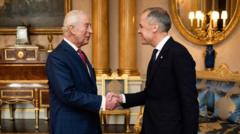In a noteworthy demonstration of political strategy and cultural identity, Canadian Prime Minister Mark Carney, shortly after assuming office, extended an invitation to King Charles III to attend the opening of Canada’s 45th parliament. This historical moment stands in stark contrast to the tumultuous past where invitations to British royalty were met with mixed reactions, particularly under Prime Minister Stephen Harper’s administration.
A decade ago, Harper’s efforts to reinvigorate Canada’s ties to the British monarchy sparked outrage, leading to the removal of the Queen’s portrait from Parliament. In contrast, the current political climate sees the King’s visit as a representation of Canada’s sovereignty and independence, particularly against the backdrop of U.S. President Donald Trump’s disparaging comments regarding Canadian identity and economic stability.
Royal historian Justin Vovk characterized Carney's invitation as a “huge affirmation” of Canada's uniqueness, asserting that it symbolizes a definitive stance against being perceived as an extension of the United States. “It’s a theatrical display that aims to highlight what distinguishes Canadians from Americans,” he explained, pointing to the gradual evolution of Canada’s relationship with the Crown.
Historically, Canada's ties to the British monarchy have endured significant twists and turns, particularly influenced by the political movements within Quebec. The nation's gradual move towards independence culminated in the 1982 repatriation of its constitution, yet the parliamentary system remains closely modeled after Britain’s.
King Charles III's forthcoming presence in Canada is remarkable as it has been decades since a sovereign monarch officially addressed a new parliamentary session. This visit also comes at a critical juncture, as Carney's commitment to standing up to Trump resonates amid threats to Canadian sovereignty stemming from Trump's rhetoric and economic policies.
Despite a general indifference among Canadians towards the monarchy, there’s intrigue surrounding the ceremonial aspects of this visit. However, it also provokes discussions on reconciliation with Indigenous peoples and questions about the Crown’s historical role in these matters.
As the King and Queen prepare for their visit, set to take place imminently, the implications of this diplomatic gesture extend far beyond ceremonial tradition. It reaffirms Canada’s identity on the world stage, strengthens ties to Europe, and provides a foundation for potential improvement in U.S.-Canada relations amid ongoing political tensions.
With hopes for a significant and impactful engagement, the royal visit promises to be a pivotal moment in reaffirming the bonds between Canada and the British monarchy, one that underscores Canada's continuing journey toward self-definition in a complex international landscape.
A decade ago, Harper’s efforts to reinvigorate Canada’s ties to the British monarchy sparked outrage, leading to the removal of the Queen’s portrait from Parliament. In contrast, the current political climate sees the King’s visit as a representation of Canada’s sovereignty and independence, particularly against the backdrop of U.S. President Donald Trump’s disparaging comments regarding Canadian identity and economic stability.
Royal historian Justin Vovk characterized Carney's invitation as a “huge affirmation” of Canada's uniqueness, asserting that it symbolizes a definitive stance against being perceived as an extension of the United States. “It’s a theatrical display that aims to highlight what distinguishes Canadians from Americans,” he explained, pointing to the gradual evolution of Canada’s relationship with the Crown.
Historically, Canada's ties to the British monarchy have endured significant twists and turns, particularly influenced by the political movements within Quebec. The nation's gradual move towards independence culminated in the 1982 repatriation of its constitution, yet the parliamentary system remains closely modeled after Britain’s.
King Charles III's forthcoming presence in Canada is remarkable as it has been decades since a sovereign monarch officially addressed a new parliamentary session. This visit also comes at a critical juncture, as Carney's commitment to standing up to Trump resonates amid threats to Canadian sovereignty stemming from Trump's rhetoric and economic policies.
Despite a general indifference among Canadians towards the monarchy, there’s intrigue surrounding the ceremonial aspects of this visit. However, it also provokes discussions on reconciliation with Indigenous peoples and questions about the Crown’s historical role in these matters.
As the King and Queen prepare for their visit, set to take place imminently, the implications of this diplomatic gesture extend far beyond ceremonial tradition. It reaffirms Canada’s identity on the world stage, strengthens ties to Europe, and provides a foundation for potential improvement in U.S.-Canada relations amid ongoing political tensions.
With hopes for a significant and impactful engagement, the royal visit promises to be a pivotal moment in reaffirming the bonds between Canada and the British monarchy, one that underscores Canada's continuing journey toward self-definition in a complex international landscape.




















